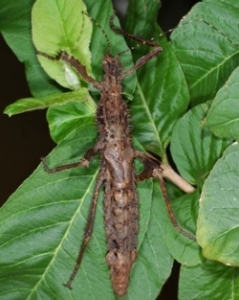 P. mocquerys,
P. mocquerys,
Credit: Oskar V. Conle P. mocquerys,a rare walkingstick found only in Madagascar.
Walkingstick’s novel monoterpene shows activity against tumor cells
Camouflage is not the only trick Madagascar walkingsticks use to thwart their enemies. These insects also spray a defensive fluid, and a team of researchers hopes the fluid’s key chemical, parectadial, will ward off a human enemy: cancer.
The team, led by biochemistry professor Arthur S. Edison of the University of Florida, details their discovery and characterization of parectadial along with their development of a synthetic route to this novel monoterpene (J. Nat. Prod., DOI: 10.1021/np070151g).
Studying an insect’s defensive fluid is often a challenge because the sample size typically is minuscule. Edison’s team overcame this obstacle by using microsample NMR technology aimed at analyzing natural products (C&EN, Sept. 25, 2006, page 15). Analysis of venom from the Madagascar walkingstick (Parectatosoma mocquerysi) revealed a monoterpene dialdehyde that Edison’s team named parectadial.